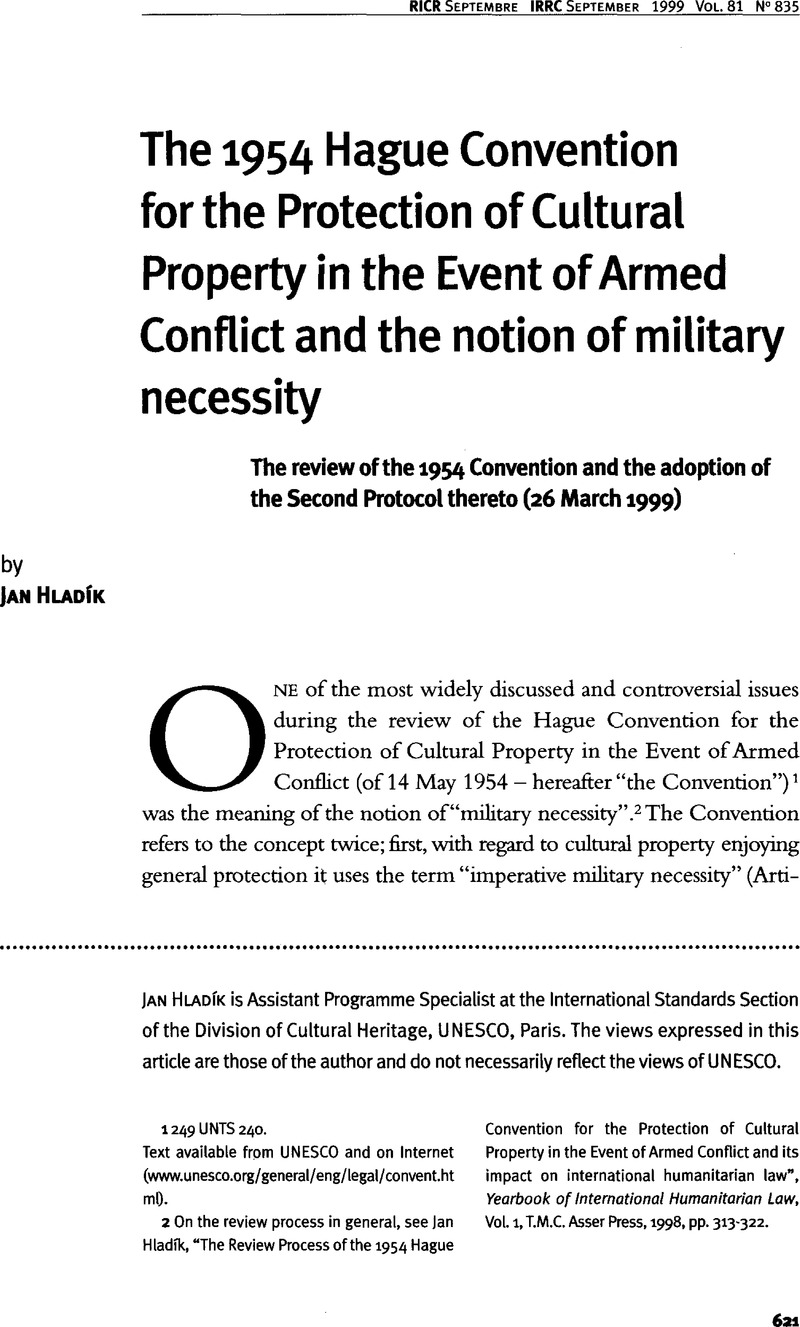Article contents
The 1954 Hague Convention for the Protection of Cultural Property in the Event of Armed Conflict and the notion of military necessity
Published online by Cambridge University Press: 19 April 2010
Abstract

- Type
- Research Article
- Information
- Copyright
- Copyright © International Committee of the Red Cross 1999
References
1 249 UNTS 240.
Text available from UNESCO and on Internet (www.unesco.org/general/eng/legal/convent.html).
2 On the review process in general, see Hladík, Jan, “The Review Process of the 1954 Hague Convention for the Protection of Cultural Property in the Event of Armed Conflict and its impact on international humanitarian law”, Yearbook of International Humanitarian Law, Vol. 1, T.M.C. Asser Press, 1998, pp. 313–322.CrossRefGoogle Scholar
3 Article 4 -UNESCO Draft – Obligations in respect of cultural property situated within the territory of another Contracting Party
1. Each High Contracting Party undertakes to respect cultural property situated within the territory of another High Contracting Party, except in cases of imperative military necessity.
2. In particular, each Party undertakes not to use movable cultural property for purposes which might expose it to destruction or damage. It further undertakes not to remove or requisition movable cultural property or the material for its protection and to take the necessary measures to prevent or put a stop to any form of theft and any act of damage or destruction not justified by imperative military necessity.
Records of the Conference convened by the United Nations Educational, Scientific and Cultural Organization held at The Hague from 21 April to 14 May 1954, published by the Government of the Netherlands, The Hague, 1961, p. 374.
4 Article 11 - UNESCO Draft – Withdrawal of immunity
4. Subject to paragraph 1 of the present article, immunity shall be withdrawn from cultural property under special protection only in cases of unavoidable military necessity, and only for such time as that necessity continues. Such necessity can be established only by the staff of the large formation in charge of the operation concerned. Whenever circumstances permit, the opposing Party shall be notified, a reasonable time in advance, of the decision to withdraw immunity. Ibid., p. 381.
5 ibid., p. 309.
6 Ibid.
7 ibid., p. 310
8 Cuba, ibid., p. 151
9 United States of America, ibid., p. 141.
10 Information on the implementation of the Convention for the Protection of Cultural Property in the Event of Armed Conflict (The Hague, 1954), 1995 Reports, UNESCO doc. CLT- 95/WS/13, Paris, December 1995, p. 23Google Scholar.
11 Review of the application of the Convention for the Protection of Cultural Property in the Event of Armed Conflict (The Hague, 1954), UNESCO doc. 140 EX/26, Paris, 11 September 1992, p. 6Google Scholar.
12 Boylan, P.J., Review of the Convention for the Protection of Cultural Property in the Event of Armed Conflict (The Hague Convention of 1954), UNESCO doc. CLT-93/WS/12, Paris, 1993.Google Scholar
13 In fact, the author of the report means “Article 4, para. 2”. J.H.
14 Op. cit. (note 12), p. 57.
15 Summary of comments received from States Parties to the Hague Convention and from the International Council on Archives, UNESCO doc. CLT-96/CONF.603/INF.4, Paris, December 1996, pp. 2–4Google Scholar.
16 Meeting of governmental experts on the review of the Hague Convention for the Protection of Cultural Property in the Event of Armed Conflict 1954, UNESCO doc. CLT-96/CONF.603/5, Paris, 30 April 1997, p. 2.Google Scholar
17 Draft provisions for the revision of the 1954 Hague Convention and commentary from the UNESCO Secretariat, UNESCO doc. CLT-97/CONF.208/2, Paris, October 1997, p. 3.Google Scholar
18 See text in Annex 1.
19 Preliminary Draft Second Protocol to the 1954 Hague Convention, HC/1999/1, October 1998, distributed by the Netherlands in preparetion for the Diplomatic Conference to be held in the Netherlands in March 1999. See texts in Annexes 2 and 3.
20 Draft Second Protocol to the 1954 Hague Convention for the Protection of Cultural Property in the Event of Armed Conflict, HC71999/1/rev.1, February 1999, distributed by the Netherlands. See Annexes 4 and 5.
21 See texts in Annexes 6 and 7.
22 Carnahan, B. M., “Lincoln, Lieber and the laws of war: The origins and limits of the principle of military necessity”, American Journal of International Law, Vol. 92, No. 2, April 1998, p. 231.CrossRefGoogle Scholar
- 6
- Cited by




